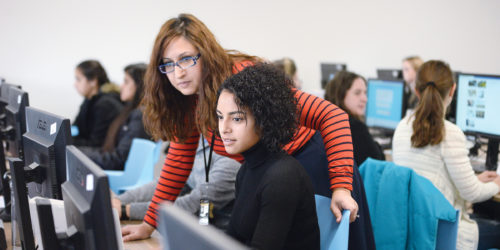Understanding Equity, Inclusion, and Teaching During a Pandemic
By Lisa Trimble
Edited by Sara Kafashan
By now, you’ve probably heard the expression (perhaps often these days) “We’re weathering the same storm, but we’re not all in the same boat.”
With the onset of the pandemic, our rapid pivot to online teaching and learning happened quickly for educators around the world. Our students are still living the same issues around equity and inclusion they always have, but some of these issues may be less visible or more difficult to navigate in the online learning context. Teaching online can (and and must!) be done with intentional strategies to promote inclusion to help ensure all students are well-supported and have opportunities to succeed. This tip shares some ideas about how to do that.

Equity means ensuring everyone in our class has the same access to opportunity, resources, and supports to help them achieve their fullest potentials in their learning and career goals. Creating an inclusive learning space means students have a sense that they belong. They are connected to the course ideas, the professor, and one another in ways that foster true community. There’s a shared sense of supporting one another, and the course design is intentionally organized in ways to promote success of all students (Putnam-Walkerly & Russell, 2016).
Questions to consider around equity and online learning technology
- Do our students have the devices/wifi connections and technical know-how to be able to navigate our courses easily? If not, how can we support them?
- How are we creating connection and community for our students so they don’t feel isolated during online teaching and learning experiences?
- Have you considered mobile device access and students’ data plans?
Many of our students are accessing our courses through their phones or tablets. Try to view your own course materials on your own mobile device. Do they display well? If your students don’t have robust data plans, is your course easy to navigate without consuming lots of data? If you post a recording of your online synchronous class, are you also posting materials that students can access asynchronously without a need for using a lot of data? Posting a recording of the Zoom class as well as the PowerPoint (being cognizant of images and image sizes) on its own is helpful for students with limited access to mobile data.
Questions to consider around structuring and presenting content
- How does the organization of my course help or get in the way of students being able to find what they need, when they need it?
- Is your material organized in a way that is predictable and consistent throughout? Ensure you follow eConestoga Essential Elements to support consistency across Conestoga courses.
- When you name the materials that you upload into eConestoga, do you identify what kind of resource it is? Labelling everything clearly helps students to recognize and easily navigate your course materials. A consistent file naming system–one that identifies file content in the title–makes information easier for students to search and retrieve. Here are a few examples:
- Week 1 presentation notes: Social dimensions of health (for a PPT)
- How poverty impacts learning [2:30] (for a video link)
- Table of Health Concerns by Region (for a PDF)
- Are you representing the information presented in your teaching in multiple ways to achieve the same learning outcomes? For example, in addition to videos, are you including images, tables, charts, infographics, additional links, etc.? Have you compressed large files?
Thoughts on promoting and creating spaces for inclusion
During the pandemic, I’ve been hearing from faculty how much we all miss seeing our students, engaging with them in person, having class discussions, and thinking through ideas together. Sometimes when I’ve been delivering faculty workshops via Zoom, some faculty members have asked if I would be able to create breakout rooms at the end of the workshop so they could visit with some of their friends and colleagues who were also participants. We miss the social aspect, the checking in, the support, and the laughter we share in our personal interactions when we’re teaching on campus. Our students miss these aspects as well. Creating space for social time at the end of a Zoom lesson is one way to allow students to re-connect and visit.
Another way to promote community is to create a virtual café in your discussion forums in eConestoga (with bonus points if you can come up with a fun, interesting name for it!). Inviting students to connect in a hang-out space where they can post memes, share supportive thoughts, and celebrate life events and accomplishments is an easy way to build community in your class.
Get to know each other and create friendships in your class with a free and easy-to-use app such as Flipgrid to do short introductions and answer a few fun questions about themselves. This is a great way to get to see one another’s face, learn how to pronounce each other’s names and humanize the remote learning experience. For some inspired discussions about how faculty at Conestoga have used Flipgrid in their own teaching, see this post by Business professor Kim Carter, or this one by Business professor Claire Palvetzian.
If you are looking for some other apps that will help create community and engage with active learning while teaching remotely, check out this infographic on Key Apps for Teaching and Learning by Teaching and Learning’s Jesslyn Wilkinson. There are some fabulous ideas there that are easy to integrate and will help to build relationships and engagement with your course.
Equity and inclusion keeps our boats closer together
Maya Angelou famously observed, “Every storm runs out of rain…if it’s bad it might get worse, but I know it’s going to be better.” We have an opportunity ahead of us now as educators. Teaching with good planning, intentional strategies, and strong structures can support learners to weather the storm. Equity and inclusion keeps everyone closer together. And together–with all of our students–we can adapt, learn, and support one another until this storm finally runs out of rain.
You can explore the ideas outlined in this post more deeply by signing up for the Envisioning Inclusivity as a Core Teaching Value and Practice workshop (PDEV 0742). To learn more about the Teaching and Learning Summer 2020 Workshop Series, visit the Teaching and Learning Workshop page, view the workshop documents for details, then choose a time from the drop-down menu and register.
References
Putnam-Walkerly, K. & Russell, E. (2016) What the Heck Does ‘Equity’ Mean?



